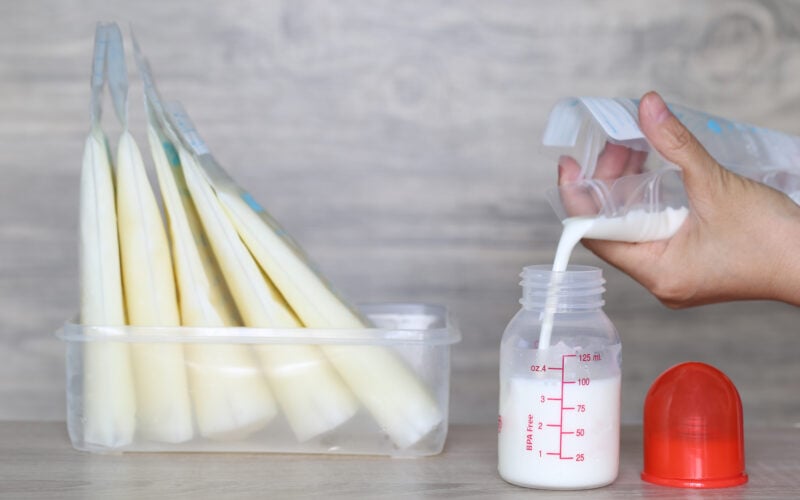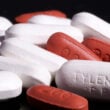You might have heard that breast milk has superpower properties, can heal wounds faster than neosporin, and is perfectly calibrated for the infant at every stage of development. This is all true—and it is because breastmilk is a living, constantly changing substance. That’s right: It’s alive. But what does it mean to call breastmilk a “living” substance?
All the ways your breastmilk adapts to baby’s needs
A 2017 review of literature noted that human milk complexity is generated by “individual variations in breast milk composition, which are attributed to the stage of lactation, the degree of breast fullness, infant feeding, the health of the breastfeeding dyad, and other factors” [1]. That means it’s quite literally always changing, in response to all sorts of different factors. Practically, it also means that the milk a mom makes at 2pm on a Tuesday is constitutionally different from the milk she might make 24 hours, 2 weeks, or 6 months later.
What’s more, the breastmilk a mom makes when her child is sick has more infection-fighting cells than when her child is well. And these changes and adaptations in breastmilk composition continue for as long as the mother breastfeeds. Likewise, breastfeeding remains a vital source of nutrition and immune protection for as long as breastfeeding continues; yes, even after the child is primarily consuming solids!
Even more fascinating, milk composition follows a circadian rhythm and has more sleep-inducing hormones (primarily melatonin) at night time. And the balance of fat and sugar is always in flux, too. When breasts are very full (like they are upon waking when baby blessedly sleeps a bit longer at night!), milk contains more sugar and less fat, while “emptier” breasts (e.g., towards the end of a good, long feeding) make milk higher in fat content. (This is one of the very reasons that in my work as a lactation consultant, I often tell moms that their breasts are rarely, if ever, empty—even when they feel like they are!)
What is in breastmilk that makes it “alive?”
According to this 2018 paper, “Human milk consists of 87% water, 1% protein, 4% lipid, and 7% carbohydrate (including 1 to 2.4% oligosaccharides). It also contains many minerals (Calcium, Phosphorus, Magnesium, Potassium, Sodium, etc…) and many vitamins” [2].
But in addition to its nutritional components, breastmilk contains bioactive components, including probiotics (yes, breastmilk contains friendly bacteria!) and breastmilk cells, which are derived from either the mother’s blood or her breast tissue itself. (For a visual explanation, this helpful graph breaks down the types of bioactive cells in breast milk.) The breast-derived cells contain lactocytes (milk-secretory cells), myoepithelial cells (from the milk ducts), progenitor cells (the precursors to stem cells), and stem cells.
Immunity-boosting cells in breastmilk
What do breast-derived cells do? Think of it this way: your breasts contain little receptors and filters that take in information about your environment, put it through a calculation machine and then pump out the exact formula (no pun intended) of what is needed for this specific baby at this specific moment and time.
You know how babies go through that stage where they put everything in their mouth? It often coincides with more mobility and freedom to explore their environment. They take a toy from the ground of the coffee shop or playground or day care, and put it straight into their mouth (much to your horror). But when the baby comes to the breast, their saliva contains all of these lovely germs from their environment that go into your breast via nursing and go through the computation process. Brilliant, right?
The incredible adaptability of breastmilk immune cell production plus the presence of probiotics to prime the infant’s gastrointestinal tract likely play a major role in why breastfeeding confers protection against childhood illnesses as well as diseases later in life [1]. Amazingly, research suggests that immune cells travel outside of the gastrointestinal tract (where breastmilk, just like solid foods, ends up), migrating into the infant’s bloodstream, and eventually landing in places like the lymph nodes, spleen, and liver [3].
Stem cells in breastmilk
Stem cells play a very vital role as well in the properties of breast milk. A 2014 study said that “Human milk stem cells were shown to be highly plastic and to differentiate in culture into cells from the 3 germ layers” [4]. Why might this matter? Breast milk cell components may actually play a role in baby’s development. According to the study, “Hassiotou and Hartmann (7) used mouse models to provide the first evidence that milk stem cells are transferred to different tissues of the breast-fed offspring, remaining viable and integrating within host tissue” [4]. This opens up an exciting and burgeoning field of study, built on increasing evidence that, similarly to adult stem cells, breastmilk stem cells could transform medicine for both infants and adults alike. In fact, according to the 2017 review of literature mentioned above, “breast milk is now considered a therapeutic agent suitable for use in parallel to drug therapy” such as in this case series treating Immunoglobulin A deficiency in liver transplant patients [5].
Breastmilk’s relationship to mom’s nutritional status
You may have heard that babies in the womb are very good at getting the nutrients they need to thrive, in some cases even taking from maternal stores if the mother is malnourished. The same is true of lactation. The nutritional content of breastmilk is designed for the baby, largely regardless of the mom’s diet, and will change in response to the baby’s needs as necessary.
Of course, this doesn’t mean nutrition for moms isn’t important. We’ve written in the past on the importance of nutrition in the fourth trimester, and beyond. But, again, good maternal nutrition is primarily for the health and nourishment of the mom, not the baby. Pregnancy and lactating and caregiving for small babies is very demanding on the body, and mothers need all the nourishment they can get. (Just rest assured your body is making sure your baby is getting what he or she needs from your breastmilk, regardless.)
A quick note on those tech startups that want to “assess” your milk…
Despite the fact that our bodies are very good at producing the right kind of milk at the right time for our babies, there are tech startups purporting to test moms’ breastmilk to see if it contains the ideal composition of vitamins and minerals. As a lactation consultant, I see the reality that, while baby’s nutritional needs are usually adequately met by breastmilk (supply issues aside), mom’s needs too often fall by the wayside. Therefore, I see this hyper-focus on the nutritional composition of breastmilk as a sorely missed opportunity, and misplaced time and energy (and money). We should be more focused on helping tired, new breastfeeding moms get the right nutrients they need to function as their baby’s primary caregiver in the early months and years of their baby’s life. In other words, let’s trust breastmilk to do its thing, and let’s help moms do theirs.
Breastfeeding may not always be possible, but mother-child bonding always is
For various reasons, some mothers either decide not to or simply can’t provide breastmilk for their little ones. In a vacuum where nothing else matters, the nutrition and composition of breastmilk will always win out against formula–after all, they have yet to invent a formula that can literally change in response to a baby’s daily needs! But we do live in a real world with real people and real life factors, and the inability to breastfeed (for whatever reason) is a reality that many women have to come to terms with.
In my experience as a lactation consultant, many moms mourn the “loss” of breastfeeding as a lost opportunity to bond with their babies. That’s why one of the clarifying questions I ask moms as they process their options and priorities is “If you had to choose between breastmilk in a bottle or formula from the breasts….what would you choose?” Because the truth is, feeding in any form is a wonderful opportunity for parent/baby bonding. And many of the crucial bonding opportunities that are naturally built into breastfeeding, like skin-to-skin contact and forming early communication cues, are still possible when bottle feeding. When breastfeeding is recognized as the biological norm, we can orient all caregiving (including feeding) practices to this norm, and it won’t have to feel quite so charged anymore.
So…it’s true. Breastmilk is an amazing and quite literally alive substance, that you can feel confident is meeting all the right nutritional (and even many of the immunological and emotional) needs of your baby at every stage of her development.. And then one day, she’ll be a toddler who will take a week-old squished raspberry from the crack of the couch and happily eat it. C’est la vie!
References:
[1] Witkowska-Zimny M, Kaminska-El-Hassan E. Cells of human breast milk. Cell Mol Biol Lett. vol 22, no. 11 (2017). doi: 10.1186/s11658-017-0042-4. PMID: 28717367; PMCID: PMC5508878. [2] Boquien, Clair-Yves. “Human milk: an ideal food for nutrition of preterm newborn.” Frontiers in Pediatrics, vol. 6 (2018). https://doi.org/10.3389/fped.2018.00295 [3] Cabinian A, et al. Transfer of Maternal Immune Cells by Breastfeeding: Maternal Cytotoxic T Lymphocytes Present in Breast Milk Localize in the Peyer’s Patches of the Nursed Infant. PLoS One, vol. 11, no 6 (2016):e0156762. doi: 10.1371/journal.pone.0156762. PMID: 27285085; PMCID: PMC4902239. [4] Bode L, McGuire M, Rodriguez JM, Geddes DT, Hassiotou F, Hartmann PE, McGuire MK. It’s alive: microbes and cells in human milk and their potential benefits to mother and infant. Adv Nutr. vol. 5, no. 5 (2014): pp. 571-3. doi: 10.3945/an.114.006643. PMID: 25469400; PMCID: PMC4188237. [5] Merhav, H J et al. Treatment of IgA deficiency in liver transplant recipients with human breast milk.” Transplant international : official journal of the European Society for Organ Transplantation vol. 8,no. 4 (1995): pp. 327-9. doi:10.1007/BF00346889Additional Reading:
Do you need to wean from breastfeeding while trying to conceive?
The eco-friendly baby feeding option: How breastfeeding benefits the environment
Is birth control safe while breastfeeding?
Yes, you can chart with a fertility awareness method while breastfeeding!











